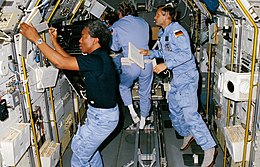
Back STS-61-A Arabic STS-61A Bulgarian STS-61-A Czech STS-61-A Danish STS-61-A German STS-61-A Spanish STS-61-A Estonian استیاس-۶۱-ای Persian STS-61-A French STS-61-A Galician
 Guion Bluford, Reinhard Furrer, and Ernst Messerschmid in Spacelab Module LM2, serving as the Spacelab D1 laboratory. | |
| Names | Space Transportation System-22 Spacelab D-1 |
|---|---|
| Mission type | Microgravity research |
| Operator | NASA, West Germany and ESA |
| COSPAR ID | 1985-104A |
| SATCAT no. | 16230 |
| Mission duration | 7 days, 44 minutes, 51 seconds |
| Distance travelled | 4,682,148 km (2,909,352 mi) |
| Orbits completed | 112 |
| Spacecraft properties | |
| Spacecraft | Space Shuttle Challenger |
| Launch mass | 110,568 kg (243,761 lb) |
| Landing mass | 97,144 kg (214,166 lb) |
| Payload mass | 14,451 kg (31,859 lb) |
| Crew | |
| Crew size | 8 |
| Members | |
| Start of mission | |
| Launch date | October 30, 1985, 17:00:00 UTC (12:00 pm EST) |
| Launch site | Kennedy, LC-39A |
| Contractor | Rockwell International |
| End of mission | |
| Landing date | November 6, 1985, 17:44:51 UTC (9:44:51 am PST) |
| Landing site | Edwards, Runway 17 |
| Orbital parameters | |
| Reference system | Geocentric orbit |
| Regime | Low Earth orbit |
| Perigee altitude | 319 km (198 mi) |
| Apogee altitude | 331 km (206 mi) |
| Inclination | 57.00° |
| Period | 91.00 minutes |
 STS-61-A mission patch  Back: Nagel, Bluford, Messerschmid and Ockels Front: Furrer, Dunbar, Buchli and Hartsfield | |
STS-61-A (also known as Spacelab D-1) was the 22nd mission of NASA's Space Shuttle program. It was a scientific Spacelab mission, funded and directed by West Germany – hence the non-NASA designation of D-1 (for Deutschland-1). STS-61-A was the ninth and last successful flight of Space Shuttle Challenger before the disaster. STS-61-A holds the current record for the largest crew—eight people—aboard any single spacecraft for the entire period from launch to landing.
The mission carried the NASA/European Space Agency (ESA) Spacelab module into orbit with 76 scientific experiments on board, and was declared a success.[1] Payload operations were controlled from the German Space Operations Center in Oberpfaffenhofen, West Germany, instead of from the regular NASA control center.[2] This was the first spaceflight to include multiple crewmembers from any single country other than the United States or Soviet Union. The crew also included the first Dutch citizen astronaut, payload specialist Wubbo Ockels.
- ^ "German-run shuttle mission successful – Free Online Library". Thefreelibrary.com. November 16, 1985. Retrieved May 18, 2011.
- ^ "STS-61A Space Shuttle Challenger Mission". Space.about.com. Archived from the original on July 7, 2011. Retrieved May 18, 2011.